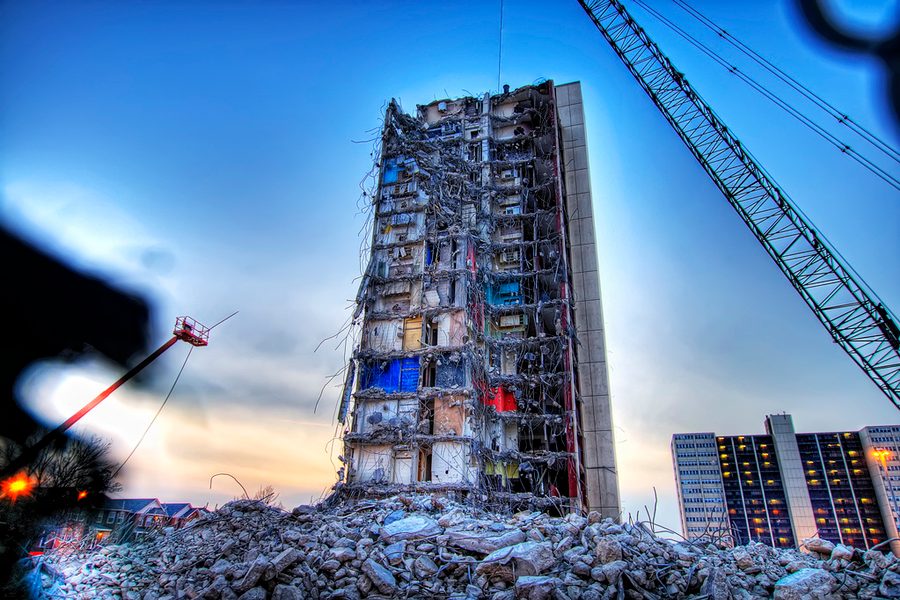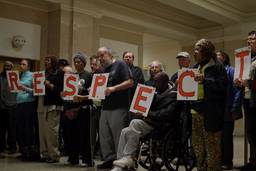Documenting the Rise and Fall of Chicago’s Cabrini-Green Public Housing Projects
A new film traces the history of America’s most famous—and infamous—housing projects.
Maya Dukmasova

From the moment it was completed, the public housing development known as Cabrini-Green has been captured in still and moving pictures. The development was not only iconic to Chicago, but a symbol of public housing all over the country, from its hope-filled foundation to its contentious demolition.
English-born filmmaker Ronit Bezalel arrived in Chicago from Canada in the 1990s and began filming at Cabrini-Green almost immediately. Her first movie, a 30-minute documentary called Voices of Cabrini (1999) captures the development at the start of the decade of demolitions that would radically reshape the city’s physical and social landscape. This month, Bezalel is screening a feature-length follow-up, 70 Acres in Chicago: Cabrini Green, a film that both tells the history of the development’s birth and shows us the 20-year metamorphosis of the neighborhood from the City’s worst fear to its desired vision of itself.
The story of Cabrini-Green begins in in 1941, with the construction of the Frances Cabrini Homes, also known as the Cabrini Rowhouses. These two-story beige brick buildings can still be seen in their neat rows as one drives down Chicago Avenue toward the Chicago River.
Built for war workers, the Rowhouses were the first integrated public housing project in the city. But the land where they were erected was not vacant and the people who moved into the 586 apartments were not the poorest of the poor. Before the CHA began its construction this part of town was known as Little Hell — a predominantly Sicilian neighborhood with shoddy housing stock and rampant crime.
As MIT Urban Design and Planning professor Lawrence Vale chronicles in his book Purging the Poorest, the building of public housing in this neighborhood was advertised as a way to uplift the poor entrapped in its insalubrious tenements. In the end, however, the new public housing wasn’t really for them. They were considered to be too poor and morally degenerate to be entrusted with the nice, new apartments. Instead, the Chicago Housing Authority populated its projects with reliably employed families who, with the Authority’s strict supervision and assistance, took good care of the buildings and did not linger long. No one knows what happened to the slum dwellers of Little Hell; any fight against the city’s devastation of their neighborhood and way of life went undocumented.
The post-war construction and population boom brought a dire need for affordable housing and CHA soon expanded its footprint in the old slums west of the Gold Coast by building mid- and high-rise projects. In 1955, when construction on the Cabrini Extension — the 15 red-brick buildings between Chicago and Division — began, the Rowhouses were no longer as diverse as they once were and the new buildings were filled mostly with working black families. This trend continued as the last part of the development — the 8 white buildings of the William Green Homes, north of Division — were completed in 1962.
By the mid-1960s, CHA projects across the city were housing almost exclusively African-Americans. But the segregation embodied by these buildings and spurred on by better, suburban housing opportunities for whites, was not yet coupled with devastating poverty. The popular notion of the projects as housing for the poorest of the poor, as warehouses of misery and pathology, did not begin to take hold until the early 1970s.
For Chicagoans who knew and lived in public housing in those years, 1968 was a turning point — particularly for Cabrini-Green. After the assassination of Martin Luther King, rioting broke out across the city and was strictly confined by police to the African-American neighborhoods. This cordoning off, as Vale notes in his book, was particularly strictly enforced around Cabrini, due to its proximity to the wealthy, white lakefront neighborhoods. Cabrini-Green, which had always been surrounded by a variety of businesses and amenities, emerged from the riots as a shadow of its former self.
The devastation of the neighborhood economy was closely tailed by a series of federal housing policy reforms which were intended to prioritize public housing access for the poorest — single mothers on welfare and the homeless. Though well-intentioned, these reforms sharply reduced rental income for the CHA, an agency already plagued by managerial and fiscal incompetence. Thus, just as the most disadvantaged Chicagoans began moving into public housing in ever larger numbers, the management of the properties was forsaken. Garbage shoots were overfilling and incinerators breaking less than a mile away in the luxury condominiums, too. But at Cabrini-Green, no one was coming to fix them.
Left to their own devices the residents — overwhelmingly children and teens — organized, governed, and cared for themselves the best way they knew how. Drug dealers preyed on the young, gangs took hold of public spaces. After two cops were killed by a sniper in the development in 1970, the project’s notoriety grew and the City gave up treating its residents like citizens altogether. One-sixth of the development’s population moved out by 1971.
Around the same time, spurred by overwhelmingly negative local media attention, Cabrini-Green gained a broader cultural currency in fictionalized portrayals such as the TV sitcom Good Times and the film Cooley High. In 1992 these depictions hit a terrifying nadir in Candyman, a horror film set in Cabrini-Green. Director Bernard Rose said that he chose the location “because it was a place of such palpable fear.” An irrational fear, he admitted, a fear of outsiders towards African-Americans and the poor.
Raymond McDonald, who is a central character in Bezalel’s 70 Acres grew up knowing this fear and seeing it shape his world. His neighborhood “had a negative stigma to it — don’t go there: killers, robbers, black people,” he said at a recent screening of Bezalel’s first film.
Throughout 70 Acres we watch McDonald watch the neighborhood he knows and loves give way to a new community designed to exclude him. In the mid-90s the federal government created a new program that gave local housing authorities millions of dollars to demolish severely deteriorated public housing buildings and build new homes in their stead. Much like the projects were in their early years, these new communities were premised on the idea of uplifting the poor. However, having given up on the idea that architecture and design could save the poor from their poverty, planners and politicians turned to the concepts of “mixed-income housing.” The thing that would surely save the poor, they thought, was proximity to richer neighbors.
Cabrini-Green was the first site of this experiment, but by the early 2000s it was taken to scale across Chicago under Mayor Richard M. Daley’s $1.5 billion Plan for Transformation. The footage in 70 Acres bookends this tumultuous period for the city’s poorest residents. It begins at the beginning, as the first of the Cabrini-Green high-rises are torn down in 1995 and ends at the end, when the last of Chicago’s public housing towers, Cabrini-Green’s 1230 N. Burling is demolished.
At the start of the film, the film’s crew captures lively scenes at community meetings as city leaders pitched their vision of the future while public housing residents responded with skepticism and disbelief. They had a feeling that what was coming to “uplift” wasn’t really meant for them.
“This new community is not about exclusion, it’s not about kicking everybody out,” says a representative from Mayor Daley’s office, showing renderings of the future of the neighborhood — townhomes and a condo building along a tree-lined street. “We can’t afford that!” yells someone from the audience. The representative tries to continue his rehearsed speech despite growing clamor. “I’m sick of oppression and moving black people out of these communities,” a woman says loudly.
At another meeting a community activist criticizes a city official for not consulting with Cabrini-Green residents before launching into demolitions. She chastises the man for interrupting her. “You interrupted a way of life over here lady!” he yells back.
As the demolitions continued through the early 2000s, large groups of residents marched, picketed, and even sued the city to win the right to take part in the planning for the new neighborhood. But despite their efforts very few were able to return and live at the new mixed-income developments that have been built in Near North.
Just as Little Hell had been purged of its poorest residents, so was the Cabrini-Green neighborhood. Only the choicest families who met a strict set of requirements were allowed to return to the new housing with idyllic names like Parkside of Old Town. As one such resident, Deirdre Brewster puts it in 70 Acres, to come back to the community “you actually have to be a nun. There’s no room for mess-ups. But I think it’s kind of dehumanizing.”
For Brewster the apartment at Parkside came at the expense of her relationship with her eighteen-year-old daughter. Because the girl had a misdemeanor on her record for a fight at school she could not be on Brewster’s lease. Guests at public housing apartments in her community were also strictly monitored. Brewster’s daughter had to stay with relatives. “God forbid she ends up homeless,” Brewster says in the film, “what am I supposed to do as a mom — not let her in?”
The idea of mixed-income housing was partly inspired by architectural New Urbanism (which favored low-rise residential and commercial architecture woven into city street grids), and partly by neoliberal notions of competition and self-realization. The poor would pick themselves up out of poverty if they just lived next to more affluent people who could offer them a positive example of how to live and work, the reasoning went. David Simon’s recent HBO miniseries on Yonkers captures how these ideas took hold of city planners.
“There was this whole belief that if so-called public housing residents…move next door to such affluent neighbors that would make them better people, which was very insulting,” says Brewster in 70 Acres.
McDonald is just fifteen when he first appears in footage from 2007, but he is articulate about what the loss of the public housing buildings means. “Mayor Daley is moving us out to get a higher class of people in,” he says.
In an unexpected encounter, McDonald and his friends are able to speak to Daley directly. “How do you think we feel about the community, the buildings being torn down?” McDonald asks. Daley bumbles, “In the long run public high rises will be taken down all over the country.” But McDonald’s friend presses the mayor: “If you grew up in Cabrini would you want them to take your memories?”
Daley waxes poetic. “Memory always stays within the mind, but every community changes. You can’t live in the past. No one lives in the past.”
Living in the past. In American culture this phrase signifies a kind of backwardness, something anathema to the national spirit of progress. But if we’re talking about quite literally living in the past — living in family homes, neighborhoods where one is rooted, much as the Daleys are in Bridgeport — it is a pleasant reality afforded to many wealthy and middle class people. What was the point of building suburbs if not to allow families to anchor themselves to a piece of land, to live a life rooted in space and time? After the Second World War the federal government realized that living in and with the past is a great way to build a stable society, to reduce the likelihood of social unrest by pinning people to homes they wouldn’t want to risk losing.
The projects weren’t supposed to be a place where you lived in the past. They were designed as temporary waystations to permanent homes, built on the cheap, meant at first for high turnover and later for warehousing a population that wasn’t wanted anywhere else. But even as more and more families became stuck in the projects for lack of better housing opportunities, Cabrini-Green and other developments became home over time.
This is what McDonald felt acutely as he reflected on the loss of his community. Generations of families lived there and built their memories in those apartments despite the violence, deterioration, and stigma surrounding their neighborhoods. Lest one think they had no right to do so on the public dime, it is worth remembering that the majority of Americans did so as well, out in the suburbs, subsidized by government-insured mortgages and tax deductions.
But the loss of community is not the only thing to lament as we consider the demise of Cabrini-Green. As Chicago gave up on its public housing so too did it give up on the idea of providing permanently affordable homes. Of course the political climate had changed drastically since the New Deal, and those in power were not interested in this mission anymore. But the reasons for the shift were and continue to be repeated like a mantra — we tried this and it didn’t work. The answer suggested by the collusive forces of elected officials, financiers, and developers was that private entities would do a better job of building and managing housing for the poor.
The fact is, though, that the CIty never really tried to make it work. Elsewhere in the country, such as New York, where public housing has always been seen by the authorities as a necessity and a public good, it has worked. While it has not been without its problems, New York’s public housing, consisting of 2,600 mostly high-rise buildings (some taller than 25 floors) today houses some 400,000 residents in over 178,500 apartments . Meanwhile, Chicago failed to maintain its properties even though there were never more than 40,000 apartments in the CHA’s care. The agency’s failures were blamed on the residents.
Outsiders accused public housing residents of not taking care of their homes, not caring about their communities. But public housing developments had tight networks of social relations, many internal organizations, systems of living to combat the psychological pressure of race and class-based stigma, to overcome the total abandonment by city services and the predatory incursion of both gangs and police. Needless to say, individuals’ maintenance of their homes in these developments varied as much as they do anywhere else. When these residents protested their displacement from homes that had been hard won, the outsiders said they had no right to the housing that was never theirs to begin with.
The point that home could inspire both comfort and fear, frustration and joy, that, as Bezalel puts it, Cabrini was fraught with contradictions “like all places,” was lost on Daley and the Chicagoans who called relentlessly for the dismantling of public housing. It was assumed that the buildings had no value because they weren’t worth anything. And it was assumed, as sociologist Mary Patillo points out in the film, that the way poor people did things and what they valued was wrong.
In the first decade of the 21st century, as the red and white buildings disappeared from the 70 acres of land between Wells St. and the Chicago River, tens of thousands of people were displaced away from the area. One shortfall of the film is that we do not get to see what happened to those who ended up with Section 8 vouchers instead of permanent housing units — a fate that befell most high-rise project residents around the city as a result of the Plan for Transformation. Those who did not leave Chicago altogether ended up in poor, segregated neighborhoods on the South and West sides where they could find landlords to take their vouchers, or in the pauperizing inner-ring suburbs. Meanwhile, Near North has gentrified with the help of the mixed-income communities erected in Cabrini-Green’s stead, and Bezalel poignantly captures this social transformation.
One white man from a market-rate home in the new neighborhood assumed that the people in subsidized homes did not know “how to earn a living, or be proud of yourself, and be proud of what you have.” Another was frustrated that they did not pay close enough attention to the parking spot assignments. As more and more white people arrived in the area, Black residents were increasingly excluded from parks and playgrounds.
Catherine Crouch, the film’s editor and writer, cleverly juxtaposes scenes of class-coded interactions around public space. Particularly striking is footage of a sparsely attended block party organized by mixed-income homeowners contrasted with Cabrini Green reunion picnics which brought hundreds of people weekly to Seward Park.
For most of its history, people with cameras have not treated Cabrini-Green kindly. Between lurid horror film, and no-less lurid news footage, between real tragedies like the shooting death of Dantrell Davis and the tragicomedy of Cooley High, this project became the disgraced and disturbing image of public housing in America. The organizing efforts, opinions, and aspirations of its residents were lost among sensational news accounts of their violence and delinquency. Bezalel, an outsider not just to public housing and to Chicago, but to the country, does not attempt to diminish the suffering and chaos residents endured. But she captures them in context, in action, in relation with a city that wants them gone and with a home that’s hard to let go. Like the displaced residents of Little Hell, the residents of Cabrini-Green are mostly gone. But thanks to Bezalel’s documentation efforts of the past 20 years, they will not be forgotten.
Bezalel is also striving to make the film an occasion for the community to engage in a discussion about public housing. There were panel discussions with McDonald, Brewster, and the film’s writer and editor Catherine Crouch at the first round of screenings in August. She has also brought her first film from the vault for a screening and discussion during the Architecture Biennial. And, after community members criticized the lack of references to the Rowhouse residents’ continued legal fight to save their homes, added an epilogue to 70 Acres.
70 Acres is not an exhaustive history of Cabrini-Green, but it covers as much ground as a one-hour film can. Especially to those audiences unfamiliar with its history, ithe film will be highly educational. For those who lived this history, it is a record of their presence on a land from which they have been erased. It reminds all of us that the attachment to home is a privilege in this country, one that the poor are considered to have no right to.
70 Acres in Chicago: Cabrini Green will be screening at the Gene Siskel Film Center November 13-19.
Maya Dukmasova is a senior writer at the Chicago Reader. Her articles and translations have appeared in Harper’s, Jacobin, Slate, the Appeal, Places Journal, the Chicago Reader, and the Chicago Tribune. Follow her on Twitter: @mdoukmas.







